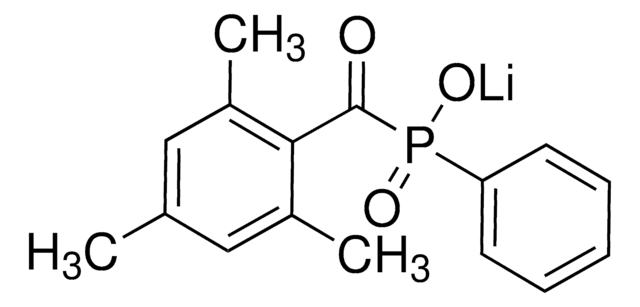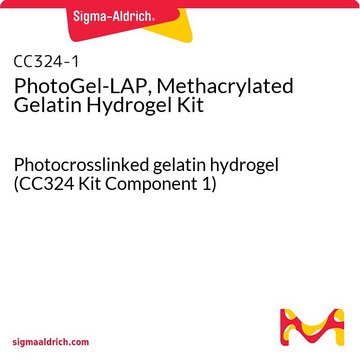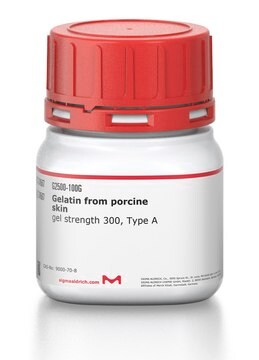おすすめの製品
詳細
Gelatin methacryloyl (GelMA) is a polymerizable hydrogel material derived from natural extracellular matrix (ECM) components. Due to its low cost, abundance, and retention of natural cell binding motifs, gelatin has become a highly sought material for tissue engineering applications. Laminin is an extracellular matrix multidomain trimeric glycoprotein and is the main non-collagenous component of basal lamina that supports adhesion, proliferation and differentiation. Laminin is composed of both A, B1 and B2 chains, which are connected by many disulfide bonds. This laminin product was isolated from mouse Engelbreth-Holm-Swarm tumor. Laminin proteins are integral components of structural scaffolding in animal tissues. They associate with type IV collagen via entactin and perlecan and bind to cell membranes through integrin receptors, dystroglycan glycoprotein complexes and Lutheran blood group glycoproteins.
アプリケーション
The addition of photocrosslinkable methacrylamide functional groups in GelMA allows the synthesis of biocompatible, biodegradable, and non-immunogenic hydrogels that are stable in biologically relevant conditions and promote cell adhesion, spreading, and proliferation Gelatin methacrylate based bioinks have been used to bioprint osteogenic , chondrogenic , hepatic , adipogenic , vasculogenic , epithelial , endothelial , cardiac valve , skin , tumor and other tissues and constructs. Laminin has active domains for collagen binding, cell adhesion, heparin binding, and neurite outgrowth fragment. Laminin has been used in tissue engineering applications for corneal , organoids and neurodegenerative diseases .
TissueFab® bioink kit
(Gel)ma Laminin -UV/365 nm, low endotoxin features a ready-to-use bioink that is formulated for high cell viability, and printability and is designed for extrusion-based 3D bioprinting and subsequent 365 nm light crosslinking and a solution of Laminin to enhance the bioink. The bioink kit can be used with most extrusion-based bioprinters, are biodegradable, and are compatible with human mesenchymal stem cells (hMSCs) and other diverse cell types. TissueFab®- Low endotoxin GelMA-UV Laminin kit enables the precise fabrication of 3D cell models and tissue constructs for research in 3D cell biology, tissue engineering, in vitro tissue models, and regenerative medicine. Suitable for final Laminin concentrations up to 200ug/ml.
(Gel)ma Laminin -UV/365 nm, low endotoxin features a ready-to-use bioink that is formulated for high cell viability, and printability and is designed for extrusion-based 3D bioprinting and subsequent 365 nm light crosslinking and a solution of Laminin to enhance the bioink. The bioink kit can be used with most extrusion-based bioprinters, are biodegradable, and are compatible with human mesenchymal stem cells (hMSCs) and other diverse cell types. TissueFab®- Low endotoxin GelMA-UV Laminin kit enables the precise fabrication of 3D cell models and tissue constructs for research in 3D cell biology, tissue engineering, in vitro tissue models, and regenerative medicine. Suitable for final Laminin concentrations up to 200ug/ml.
特徴および利点
In addition to fast gelation, the methacrylamide functional group can also be used to control the hydrogel physical parameters such as pore size, degradation rate, and swell ratio. Temporal and spatial control of the crosslinking reaction can be obtained by adjusting the degree of functionalization and polymerization conditions, allowing for the fabrication of hydrogels with unique patterns, 3D structures, and morphologies.
Low Endotoxin, low bioburden: Endotoxins have been demonstrated negatively impact cellular growth, morphology, differentiation, inflammation and protein expression. Bioburden is defined as the number of contaminated organisms found in a given amount of material. We test each lot for endotoxins as well as total bioburden (aerobic and fungal) to minimize unwanted interactions. For more information: https://www.sigmaaldrich.com/US/en/technical-documents/technical-article/microbiological-testing/pyrogen-testing/what-is-endotoxin
Low Endotoxin, low bioburden: Endotoxins have been demonstrated negatively impact cellular growth, morphology, differentiation, inflammation and protein expression. Bioburden is defined as the number of contaminated organisms found in a given amount of material. We test each lot for endotoxins as well as total bioburden (aerobic and fungal) to minimize unwanted interactions. For more information: https://www.sigmaaldrich.com/US/en/technical-documents/technical-article/microbiological-testing/pyrogen-testing/what-is-endotoxin
法的情報
TISSUEFAB is a registered trademark of Merck KGaA, Darmstadt, Germany
保管分類コード
10 - Combustible liquids
適用法令
試験研究用途を考慮した関連法令を主に挙げております。化学物質以外については、一部の情報のみ提供しています。 製品を安全かつ合法的に使用することは、使用者の義務です。最新情報により修正される場合があります。WEBの反映には時間を要することがあるため、適宜SDSをご参照ください。
Jan Code
927058-BULK:
927058-1KT:
最新バージョンのいずれかを選択してください:
Rachel R Besser et al.
Biomaterials science, 8(2), 591-606 (2019-12-21)
We report a water-soluble and non-toxic method to incorporate additional extracellular matrix proteins into gelatin hydrogels, while obviating the use of chemical crosslinkers such as glutaraldehyde. Gelatin hydrogels were fabricated using a range of gelatin concentrations (4%-10%) that corresponded to
Y Shi et al.
Biomedical materials (Bristol, England), 13(3), 035008-035008 (2018-01-09)
Three-dimensional bioprinting is an emerging technology for fabricating living 3D constructs, and it has shown great promise in tissue engineering. Bioinks are scaffold materials mixed with cells used by 3D bioprinting to form a required cell-laden structure. In this paper
Wanjun Liu et al.
Advanced healthcare materials, 6(12) (2017-05-04)
Bioprinting is an emerging technique for the fabrication of 3D cell-laden constructs. However, the progress for generating a 3D complex physiological microenvironment has been hampered by a lack of advanced cell-responsive bioinks that enable bioprinting with high structural fidelity, particularly
B Duan et al.
Acta biomaterialia, 10(5), 1836-1846 (2013-12-18)
Tissue engineering has great potential to provide a functional de novo living valve replacement, capable of integration with host tissue and growth. Among various valve conduit fabrication techniques, three-dimensional (3-D) bioprinting enables deposition of cells and hydrogels into 3-D constructs
Methacrylated gelatin and mature adipocytes are promising components for adipose tissue engineering.
Birgit Huber et al.
Journal of biomaterials applications, 30(6), 699-710 (2015-05-29)
In vitro engineering of autologous fatty tissue constructs is still a major challenge for the treatment of congenital deformities, tumor resections or high-graded burns. In this study, we evaluated the suitability of photo-crosslinkable methacrylated gelatin (GM) and mature adipocytes as components
ライフサイエンス、有機合成、材料科学、クロマトグラフィー、分析など、あらゆる分野の研究に経験のあるメンバーがおります。.
製品に関するお問い合わせはこちら(テクニカルサービス)





